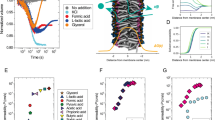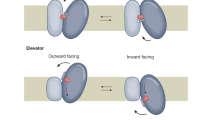Abstract
CERTAIN polypeptide antibiotics may act as membrane “carriers” translocating alkali cations and protons by forming diffusible complexes with them1. Alternatively, the antibiotics may form pores in the membrane, specific for those cations. To help to decide between these models, possible rates of penetration of polypeptide–cation complexes can be computed. The data on membrane permeability indicate, in general, a strong negative correlation between the permeability coefficient P and the number of hydrogen-bonding groups in the permeant2. A cell membrane can be characterized by two factors: (PM½)max, expressing the maximum permeability that the membrane allows for a permeant bearing no hydrogen bonding groups and also by the average reduction in P, for the chemical structure of the permeant is varied on the addition of a hydrogen-bonding site. These two parameters (recorded in Table 1) permit permeabilities for a variety of substances and cell membranes to be predicted within a factor of five2, if those with specialized permeability systems are excluded. If the polypeptide antibiotics permeate by simple diffusion, their permeabilities can then be computed from their molecular weights.
This is a preview of subscription content, access via your institution
Access options
Subscribe to this journal
Receive 51 print issues and online access
$199.00 per year
only $3.90 per issue
Buy this article
- Purchase on Springer Link
- Instant access to full article PDF
Prices may be subject to local taxes which are calculated during checkout
Similar content being viewed by others
References
Pressman, B. C., Harris, E. J., Jagger, W. S., and Johnson, J. H., Proc. US Nat. Acad. Sci., 58, 1949 (1967).
Stein, W. D., The Movement of Molecules Across Cell Membranes, chap. 3 (Academic Press, New York, 1967).
Stein, W. D., Biochem. J., 105, 3P (1967).
Hober, R., Physical Chemistry of Cells and Tissues, chap. 1 (Churchill, London, 1947).
Patlak, C. R., Bull. Math. Biophys., 19, 209 (1957).
Vidaver, G. A., J. Theoret. Biol., 10, 301 (1966).
Author information
Authors and Affiliations
Rights and permissions
About this article
Cite this article
STEIN, W. Turnover Numbers of Membrane Carriers and the Action of the Polypeptide Antibiotics. Nature 218, 570–571 (1968). https://doi.org/10.1038/218570a0
Received:
Revised:
Published:
Issue Date:
DOI: https://doi.org/10.1038/218570a0
Comments
By submitting a comment you agree to abide by our Terms and Community Guidelines. If you find something abusive or that does not comply with our terms or guidelines please flag it as inappropriate.



